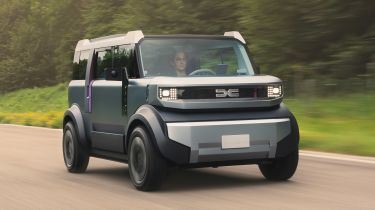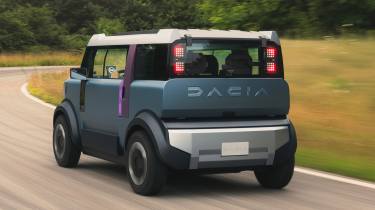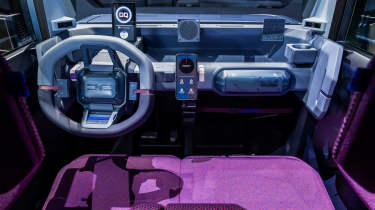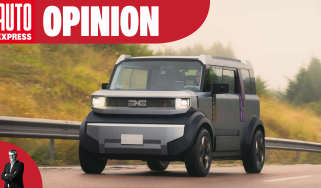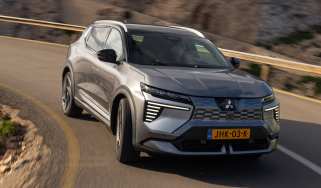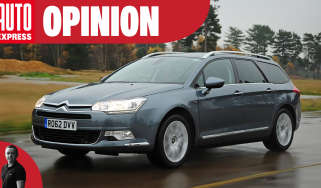New Dacia Hipster concept previews boxy £13k EV of the future
The chunky Hipster concept is Dacia’s affordable vision of an all-electric future
Everyone is talking about how to make the affordable electric car. But talk – like everything with Dacia – is cheap, so the Romanian value brand has sprung into action to deliver the Dacia Hipster, its vision of a £13,000 EV.
The chunky cube measures just three metres long but crams four seats into its flexible interior. And those tough 4x4 looks feed through to the interior: the driving position is roughly the same height as the Bigster SUV’s, to give occupants a reassuring view out.
If you're in the market for a cheap electric car, check our our Buy a Car service. You can get your hands on a new Dacia Spring from less than £12,000 or you can lease a new Dacia Spring for just over £100 per month.
How much range does the Dacia Hipster have?
The most compelling stat is that the Hipster weighs just 800kg, a whopping 20 per cent reduction on Dacia’s 3.7m-long Spring EV. Some of that weight saving comes from a right-sized battery – the Hipster would be good for about 100km or 62 miles, almost three times the typical French daily mileage – but it’s also to shrink the car’s footprint to cut mass, material cost and lower the vehicle’s carbon emissions.
Dacia unsurprisingly sees the Hipster as perfect for not just cramped cities but also the countryside, where bus routes are being cut and some retirees live on a tight budget. It’s a family’s ideal second car or “for nurses on a small salary starting work at 2am, who need a car,” David Durand, Dacia design director told Auto Express at a Paris sneak preview.
The Hipster’s a concept car that’s tackling important social issues, and right at the heart of Europe’s debate about affordable electric cars. Last month, car makers lobbied European Commission president Ursula von der Leyen, asking for law-makers to relax safety regulations to help keep cost inflation down. Dacia reckons new-car prices have soared by 30 per cent over the past four years alone, and that’s before funding another 100 new regulations expected by 2030.
As a result, the Hipster isn’t laden with the ‘active’ safety features – ones that avoid a crash, such as lane-keep assist and driver-attention monitoring – that crank up prices. Its passive safety features merely extend to driver and passenger airbags.
But that’s the trade-off and Dacia has created a relatable case study to help politicians get their head around a different automotive future. And unlike some concepts that are thinly disguised production cars, this is genuinely designed to trigger exploration and debate.
“We’re going to dig into whether this concept goes into production or whether it becomes another type of vehicle,” sales and marketing boss Frank Marotte told Auto Express in an exclusive interview. “We will study the customer needs for range, speed of charging, vehicle size, weight and active safety features. The purpose of this concept is to ask the fundamental questions that aren’t completely answered with current offers.”
Is the Dacia Hipster a car of a quadricycle?
One key question is whether it’s actually a car. Citroen’s conceptually similar Ami is in fact a quadricycle: the 2.6m-long capsule harbours only two seats and tops out at 28mph. While the Ami isn’t an uncommon sight zipping around French cities with a 14-year-old legally at the wheel, British rules limit the market and the Ami really hasn’t taken off here.
“Our vision is not to offer a two-seat [vehicle] that requires no driving licence and replaces a scooter. We want to offer a real family solution,” Dacia product performance VP Patrice Lévy-Bencheton told us. He says Dacia is open to siting the electric motor at the front or rear – whatever has the best impact on mass, weight distribution and interior space.
Industry talk is of rules that will help affordable, small cars flourish, inspired by Japan’s ‘kei car’ segment. But they are typically narrow, tall and look like cereal boxes on wheels: the Hipster is wider. And it's taller than a VW Golf, despite its stubby length. That makes for those chunky, cubic proportions, finished with a “serious but friendly” face, says Durand.
Despite being just 14 inches in diameter, the wheels don’t look tiny and are pushed to each corner to maximise interior space. But the car’s secret sauce is the interior flexibility: swivel the rear head restraints to store up against the sideglass, flip the rear seats and you transform the cargo capacity from 70 to 500 litres.
Clever touches abound: straps replace the door handles, eliminating the weight and space required for a typical latch. The glass tailgate spans the entire rear end, with the lamps set behind it to eliminate the need for a separate cover.
Painted parts are kept to a minimum and the body protection is made from Dacia’s patented ‘Starkle,’ a rugged material including recycled plastic. And expect the mesh seats to inspire future production cars’, with perches incorporating hammock-like inserts with no need for foam beneath – again saving weight. The Hipster has a small digital driver’s display, but in typical Dacia style, your smartphone provides the navigation and music – amplified on a portable speaker.
The Hipster proves that great things can come in small packages: it doesn’t look like a Noddy car, and its functionality ticks the boxes of typical supermini usage. The challenge will be establishing if there’s a market for such a small EV, with customers driving it happy to dice with Range Rovers and BMW X5s. Chances are it has to grow to make production, which would encroach on the Dacia Spring’s positioning.
The Hipster is great but leaves many questions unanswered. So the hard work starts here for Dacia – and the rest of the European car industry – on affordable EVs.
Get the latest and best car news and reviews, first! Follow Auto Express on Google today
Find a car with the experts

